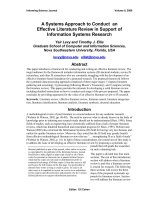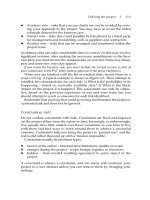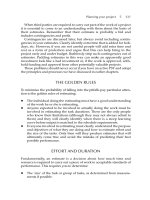wiley - project management - a systems approach to planning, scheduling, and controlling (2001)
Bạn đang xem bản rút gọn của tài liệu. Xem và tải ngay bản đầy đủ của tài liệu tại đây (33.25 MB, 1,406 trang )
TEAMFLY
Team-Fly
®
Page i
Project Management
Page ii
Dr. Kerzner's 16 Points to Project Management Maturity
1. Adopt a project management methodology and use it consistently.
2. Implement a philosophy that drives the company toward project management maturity and
communicate it to everyone.
3. Commit to developing effective plans at the beginning of each project.
4. Minimize scope changes by committing to realistic objectives.
5. Recognize that cost and schedule management are inseparable.
6. Select the right person as the project manager.
7. Provide executives with project sponsor information, not project management information.
8. Strengthen involvement and support of line management.
9. Focus on deliverables rather than resources.
10. Cultivate effective communication, cooperation, and trust to achieve rapid project management
maturity.
11. Share recognition for project success with the entire project team and line management.
12. Eliminate non
-
productive meetings.
13. Focus on identifying and solving problems early, quickly, and cost effectively.
14. Measure progress periodically.
15. Use project management software as a tool— not as a substitute for effective planning or
interpersonal skills.
16. Institute an all-
employee training program with periodic updates based upon documented lessons
learned.
Page iii
Project Management
A Systems Approach to Planning, Scheduling, and Controlling
Seventh Edition
Harold Kerzner, Ph.D.
Division of Business Administration
Baldwin-Wallace College
Berea, Ohio
Page iv
Copyright
©
2001 by John Wiley & Sons. All rights reserved.
No part of this publication may be reproduced, stored in a retrieval system or transmitted in any
form or by any means, electronic, mechanical, photocopying, recording, scanning or otherwise,
except as permitted under Sections 107 or 108 of the 1976 United States Copyright Act, without
either the prior written permission of the Publisher, or authorization through payment of the
appropriate per-copy fee to the Copyright Clearance Center, 222 Rosewood Drive, Danvers, MA
01923, (978) 750-8400, fax (978) 750-4744. Requests to the Publisher for permission should be
addressed to the Permissions Department, John Wiley & Sons, Inc., 605 Third Avenue, New York,
NY 10158
-
0012, (212) 850
-
6011, fax (212) 850
-
6008, E
-
Mail:
This publication is designed to provide accurate and authoritative information in regard to the
subject matter covered. It is sold with the understanding that the publisher is not engaged in
rendering professional services. If professional advice or other expert assistance is required, the
services of a competent professional person should be sought.
This title is also available in print as ISBN 0
-
471
-
39342
-
8 (cloth : alk. paper)
For more information about Wiley products, visit our web site at
www.Wiley.com
Page v
To
Dr. Herman Krier,
my Friend and Guru,
who taught me well the
meaning of the word "persistence"
Page vii
Contents
Preface
xix
1
Overview
1
1.0 Introduction
1
1.1 Understanding Project Management
2
1.2 Defining Project Success
5
1.3 The Project Manager
–
Line Manager Interface
6
1.4 Defining the Project Manager's Role
9
1.5 Defining the Functional Manager's Role
12
1.6 Defining the Functional Employee's Role
15
1.7 Defining the Executive's Role
16
1.8 Working with Executives
16
1.9 The Project Manager As the Planning Agent
17
1.10 Project Champions
19
1.11 The Downside Risk of Project Management
20
1.12 Project
-
Driven Versus Non
–
Project
-
Driven Organizations
24
1.13 Marketing in the Project
-
Driven Organization
26
1.14 Classification of Projects
29
1.15 Location of the Project Manager
30
1.16 Differing Views of Project Management
32
1.17 Concurrent Engineering: A Project Management
Approach
34
1.18 Total Quality Management (TQM): A Project Management
Approach
35
Problems
39
Case Studies
Jackson Industries
42
Kombs Engineering
44
Williams Machine Tool Company
45
Page viii
2
Project Management Growth: Concepts and Definitions
47
2.0 Introduction
47
2.1 General Systems Management
47
2.2 Project Management: 1960
–
1985
48
2.3 Project Management: 1985
–
2000
60
2.4 Resistance to Change
65
2.5 Systems, Programs, and Projects: A Definition
70
2.6 Product Versus Project Management: A Definition
72
2.7 Maturity and Excellent: A Definition
74
2.8 Informal Project Management: A Definition
75
2.9 Project Life Cycles
76
2.10 Project Management Methodologies: A Definition
83
2.11 Systems Thinking
86
Problems
89
Case Studies
L. P. Manning Corporation
89
Project Firecracker
90
3
Organizational Structures
97
3.0 Introduction
97
3.1 Organizational Work Flow
100
3.2 Traditional (Classical) Organization
101
3.3 Developing Work Integration Positions
105
3.4 Line
–
Staff Organization (Project Coordinator)
109
3.5 Pure Product (Projectized) Organization
110
3.6 Matrix Organizational Form
113
3.7 Modification of Matrix Structures
124
3.8 Center for Project Management Expertise
128
3.9 Matrix Layering
129
3.10 Selecting the Organizational Form
131
3.11 Structuring the Small Company
139
3.12 Strategic Business Unit (SBU) Project Management
141
3.13 Transitional Management
143
Problems
145
Case Studies
Jones and Shephard Accountants, Inc.
151
Fargo Foods
154
Quasar Communications, Inc.
156
Page ix
4
Organizing and Staffing the Project Office and Team
161
4.0 Introduction
161
4.1 The Staffing Environment
162
4.2 Selecting the Project Manager: An Executive
Decision
166
4.3 Skill Requirements for Program Managers
173
4.4 Special Cases in Project Manager Selection
180
4.5 Selecting the Wrong Project Manager
180
4.6 Next Generation Project Managers
185
4.7 Duties and Job Descriptions
186
4.8 The Organizational Staffing Process
191
4.9 The Project Office
199
4.10 The Functional Team
206
4.11 The Project Organizational Chart
208
4.12 Special Problems
211
4.13 Selecting the Project Management Implementation Team
214
Problems
217
Case Studies
Government Project Management
223
Falls Engineering
224
White Manufacturing
227
Martig Construction Company
228
The Carlson Project
229
TEAMFLY
Team-Fly
®
5
Management Functions
231
5.0 Introduction
231
5.1 Controlling
232
5.2 Directing
233
5.3 Project Authority
237
5.4 Interpersonal Influences
246
5.5 Barriers to Project Team Development
249
5.6 Suggestions for Handling the Newly Formed Team
253
5.7 Team Building As an Ongoing Process
258
5.8 Leadership in a Project Environment
260
5.9 Life
-
Cycle Leadership
261
5.10 Organizational Impact
264
5.11 Employee
–
Manager Problems
266
5.12 Management Pitfalls
270
5.13 Communications
273
5.14 Project Review Meetings
284
5.15 Project Management Bottlenecks
284
Page x
5.16 Communication Traps
286
5.17 Proverbs
288
5.18 Management Policies and Procedures
289
Problems
289
Case Studies
Wynn Computer Equipment (WCE)
303
The Trophy Project
304
Leadership Effectiveness (A)
308
Leadership Effectiveness (B)
310
Motivational Questionnaire
318
6
Time Management
325
6.0 Introduction
325
6.1 Understanding Time Management
325
6.2 Time Robbers
328
6.3 Time Management Forms
331
6.4 Introduction to Stress and Burnout
332
6.5 Stress in Project Management
336
6.6 Time Management Survey
337
6.7 Effective Time Management
352
6.8 Management Pitfalls
355
6.9 Project Communications
355
6.10 Project Management Bottlenecks
357
Problems
357
Case Studies
The Reluctant Workers
357
Time Management for Project Managers
358
7
Conflicts
379
7.0 Introduction
379
7.1 Objectives
379
7.2 The Conflict Environment
381
7.3 Managing Conflict
385
7.4 Conflict Resolution
401
7.5 Understanding Superior, Subordinate, and Functional Conflicts
402
7.6 The Management of Conflicts
405
7.7 Conflict Resolution Modes
406
Problems
408
Page xi
Case Studies
Facilities Scheduling at Mayer Manufacturing
411
Scheduling the Safety Lab
413
Telestar International
414
The Problem with Priorities
415
Handling Conflict in Project Management
416
8
Special Topics
423
8.0 Introduction
423
8.1 Performance Measurement on the Horizontal Line
423
8.2 Financial Compensation and Rewards
432
8.3 Effective Project Management in the Small Business
Organization
439
8.4 Mega Projects
441
8.5 R&D Project Management
442
8.6 Code of Ethics
453
Problems
454
Case Studies
American Electronics International
458
9
The Variables for Success
461
9.0 Introduction
461
9.1 Predicting Project Success
461
9.2 Project Management Effectiveness
466
9.3 Expectations
467
9.4 Force Field Analysis
469
9.5 Lessons Learned
474
Problems
474
10
Working with Executives
475
10.0 Introduction
475
10.1 The Project Sponsor
475
10.2 The In
-
House Representatives
488
10.3 Selling Executives on Project Management
489
Problems
499
Case Studies
The Blue Spider Project
503
Greyson Corporation
514
Page xii
Corwin Corporation
518
The Boeing 767: From Concept to Production (A)
526
The Boeing 767: From Concept to Production (B)
546
11
Planning
549
11.0 Introduction
549
11.1 General Planning
552
11.2 Identifying Strategic Project Variables
555
11.3 Life
-
Cycle Phases
558
11.4 Proposal Preparation
561
11.5 Understanding Participants' Roles
562
11.6 Project Planning
563
11.7 The Statement of Work
565
11.8 Project Specifications
570
11.9 Milestone Schedules
572
11.10 Work Breakdown Structure
573
11.11 WBS Decomposition Problems
580
11.12 Role of the Executive in Project Selection
584
11.13 Role of the Executive in Planning
587
11.14 The Planning Cycle
589
11.15 Work Planning Authorization
591
11.16 Why do plans fail?
592
11.17 Stopping Projects
593
11.18 Handling Project Phaseouts and Transfers
595
11.19 Detailed Schedules and Charts
597
11.20 Master Production Scheduling
601
11.21 Program Plan
602
11.22 Total Project Planning
608
11.23 The Project Charter
613
11.24 Management Control
616
11.25 The Project Manager
–
Line Manager Interface
616
11.26 Fast
-
Tracking
618
11.27 Configuration Management
620
11.28 Procedural Documentation
621
11.29 Established Practices
624
Problems
624
Case Studies
The Two
-
Boss Problem
634
Project Overrun
635
Margo Company
636
Denver International Airport (DIA)
638
Page xiii
12
Network Scheduling Techniques
671
12.0 Introduction
671
12.1 Network Fundamentals
674
12.2 Graphical Evaluation and Review Technique (GERT)
679
12.3 Dependencies
679
12.4 Slack Time
680
12.5 Network Replanning
686
12.6 Estimating Activity Time
690
12.7 Estimating Total Program Time
691
12.8 Total PERT/CPM Planning
692
12.9 Crash Times
694
12.10 PERT/CPM Problem Areas
698
12.11 Alternative PERT/CPM Models
700
12.12 Precedence Networks
701
12.13 Lag
704
12.14 Understanding Project Management Software
704
12.15 Software Features
706
12.16 Software Classification
708
12.17 Project Software Evaluation
709
12.18 Implementation Problems
713
Problems
714
Case Studies
Crosby Manufacturing Corporation
722
13
Project Graphics
725
13.0 Introduction
725
13.1 Customer Reporting
726
13.2 Bar (Gantt) Chart
727
13.3 Other Conventional Presentation Techniques
734
13.4 Logic Diagrams/Networks
738
Problems
740
14
Pricing and Estimating
741
14.0 Introduction
741
14.1 Global Pricing Strategies
742
14.2 Types of Estimates
743
14.3 Pricing Process
746
14.4 Organizational Input Requirements
749
14.5 Labor Distributions
750
14.6 Overhead Rates
754
14.7 Materials/Support Costs
757
Page xiv
14.8 Pricing out the Work
759
14.9 Smoothing out Department Man
-
Hours
761
14.10 The Pricing Review Procedure
762
14.11 Systems Pricing
765
14.12 Developing the Supporting/Backup Costs
766
14.13 The Low
-
Bidder Dilemma
770
14.14 Special Problems
770
14.15 Estimating Pitfalls
771
14.16 Estimating High
-
Risk Projects
772
14.17 Project Risks
773
14.18 The Disaster of Applying the 10 Percent Solution to Project
Estimates
777
14.19 Life
-
Cycle Costing (LCC)
779
14.20 Logistics Support
784
14.21 Economic Project Selection Criteria: Capital Budgeting
787
14.22 Payback Period
787
14.23 The Time Value of Money
788
14.24 Net Present Value (NPV)
789
14.25 Internal Rate of Return (IRR)
790
14.26 Comparing IRR, NPV, and Payback
791
14.27 Risk Analysis
791
14.28 Capital Rationing
792
Problems
794
TEAMFLY
Team-Fly
®
Case Studies
Polyproducts Incorporated
798
Small Project Cost Estimating at Percy
Company
801
Capital Industries
804
Payton Corporation
805
Cory Electric
806
Camden Construction Corporation
809
15
Cost Control
813
15.0 Introduction
813
15.1 Understanding Control
817
15.2 The Operating Cycle
820
15.3 Cost Account Codes
821
15.4 Budgets
828
15.5 Variance and Earned Value
829
15.6 Recording Material Costs Using Earned Value Measurement
848
15.7 The Material Accounting Criterion
850
15.8 Material Variances: Price and Usage
851
15.9 Summary Variances
853
Page xv
15.10 Status Reporting
853
15.11 Cost Control Problems
860
Problems
862
Case Studies
The Bathtub Period
873
16
Trade
-
off Analysis in a Project Environment
875
16.0 Introduction
875
16.1 Methodology for Trade
-
off Analysis
879
16.2 Contracts: Their Influence On Projects
897
16.3 Industry Trade
-
off Preferences
898
16.4 Conclusion
901
17
Risk Management
903
17.0 Introduction
903
17.1 Definition of Risk
905
17.2 Tolerance for Risk
906
17.3 Definition of Risk Management
907
17.4 Certainty, Risk, and Uncertainty
907
17.5 Risk Management Process
913
17.6 Risk Planning
914
17.7 Risk Assessment
915
17.8 Risk Identification
915
17.9 Risk Analysis
920
17.10 The Monte Carlo Process
927
17.11 Risk Handling
932
17.12 Risk Monitoring
937
17.13 The Use of Lessons Learned
938
Problems
942
Case Studies
Teloxy Engineering (A)
948
Teloxy Engineering (B)
949
18
Learning Curves
951
18.0 Introduction
951
18.1 General Theory
951
18.2 The Learning Curve Concept
953
18.3 Graphic Representation
954
18.4 Key Words Associated with Learning Curves
956
Page xvi
18.5 The Cumulative Average Curve
957
18.6 Sources of Experience
960
18.7 Developing Slope Measures
964
18.8 Unit Costs and Use of Midpoints
965
18.9 Selection of Learning Curves
965
18.10 Follow
-
on Orders
967
18.11 Manufacturing Breaks
967
18.12 Learning Curve Limitations
968
18.13 Prices and Experience
970
18.14 Competitive Weapon
972
Problems
974
Case Studies
Insight Optical Equipment Company
975
19
Managing Cultural Differences
987
19.0 Introduction
987
19.1 An Introduction to Global Projects
987
19.2 Uniqueness and Trends in Global Projects
988
19.3 Cultural Challenges Broken down by Knowledge Areas
989
19.4 The Project Manager's Checklist for Global Projects
1000
19.5 Managing during Political, Social, and Economic Reform
1000
19.6 An Introduction to Project Management in South Africa
1001
19.7 Internal Factors Affecting Project Management
1001









